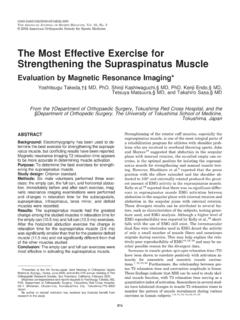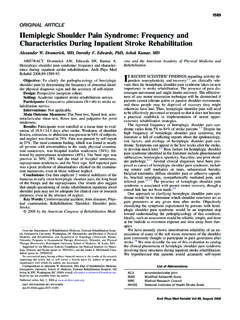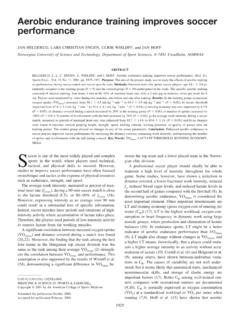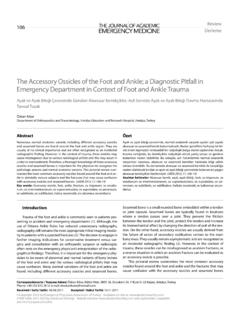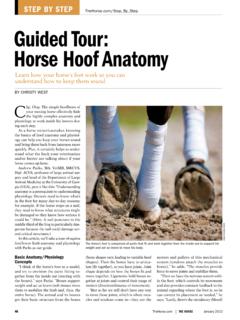Transcription of Common Injuries of the Foot and Ankle in the Child and ...
1 Common Injuries of the foot and Anklein the Child and Adolescent AthleteGerard A. Malanga, MDa,b,c,*,Jose A. Ramirez Del Toro, MDdaDepartment of Physical Medicine and Rehabilitation, University of Medicine and Dentistry,New Jersey Medical School, 30 Bergen Street, Newark, NJ 07101, USAbMountainside Hospital, 1 Bay Avenue, Montclair, NJ 07042, USAcDepartment of Rehabilitation Medicine, Pain Management Center, Overlook Hospital,MAC II Building, Suite B110, 11 Overlook Road, Summit, NJ 07091, USAdSports Medicine and Spinal Intervention, New Jersey Sports Medicine Institute,Montclair, NJ, USAOne of the most commonly injured parts of the body in adolescent athletesis the foot and Ankle . It can account for up to 30% of visits to sports medicineclinics[1,2]. Ankle sprains alone account for 10% of all Injuries seen in theemergency room[3]. Different sports can cause different types of Injuries inthe foot and Ankle .
2 In basketball, for example, foot and Ankle Injuries havebeen shown to account for 44% to 45% of all Injuries in adolescent athletes,and in the adolescent football player, the foot and Ankle make up 13% to 16%of all Injuries [4 6]. Most of these Injuries are lateral Ankle sprains. Longdistance runners report foot Injuries as the most Common injury they sustain[7 9], and adolescent runners are susceptible to overuse type of Injuries [10].Young dancers and gymnasts also have a high percentage of foot and ankleinjuries, with their specific sports mechanics often predisposing to acutefractures and fatigue fractures[11,12]. It is important that physicians feelcomfortable with the Common Injuries that can occur in the foot and ankleand be able to identify these Injuries in the young treating young athletes, physicians must keep in mind the anatomicdevelopmental differences that exist between the skeletally mature and theskeletally immature foot and Ankle .
3 These anatomic differences predisposeyoung athletes to an entirely different set of Injuries than the adult thorough understanding of general bony, ligamentous, and muscular* Corresponding Malanga).1047-9651/08/$ - see front matter 2008 Elsevier Inc. All rights Med Rehabil Clin N Am19 (2008) 347 371anatomy of the foot and Ankle is also valuable to be able to accurately devisea differential diagnosis based on symptom this article we first address, define, and explain the types of Injuries andinjury patterns germane to the developing skeletally immature athlete. Next,before discussing all the Common Injuries , we present a brief anatomic reviewof the basic bony anatomy of the Ankle and foot for reference purposes. In ananatomically oriented fashion, we outline the most Common Injuries noted inthe pediatric and adolescent Ankle and foot . There is emphasis on history,physical examination, diagnosis, and basic treatment guidelines.
4 We look atthe lateral Ankle , the medial and anterior Ankle , and the hindfoot, midfoot,and patterns in the developing athleteThe presence of a growth plate, known as the physis or the epiphysealplate, is a major difference in developing musculoskeletal structures that isnot seen in the fully mature skeleton. The long bones of children containthe physis between the metaphysis and the epiphysis (Fig. 1). Bone is laiddown for growth in the physis; however, this area is not a stable and strongarea because it is constantly changing and remodeling. There is relativeweakness at the growth plate and its surrounding bony structures as com-pared with the ligamentous structures about the pediatric and adolescentfoot and Ankle [1]. The epiphyseal plate is also less resistant to shear andtensile forces than the adjacent bony structures[13]. In adults, the oppositeis true. The bone is strong, and the sites of Injuries are in the ligamentousand muscular structures because they are the weaker points[14].
5 For example,where an inversion rollover injury would cause ligamentous injury in an adult,it is much more likely to cause injury at the growth plate in a Child , possiblyleading to a fracture of the physis or epiphyseal 1. A pictorial depiction of the metaphysis, physis, and epiphysis of the developing bone.(Adapted fromCanale ST. Physeal Injuries . In: Green NE, Swiontkowski MF, editors. Skeletaltrauma in children. 3rd edition. Philadelphia: WB Saunders; 2003. p. 17 56; with permission.)348 MALANGA & RAMIREZ DEL TOROG enerally, the Injuries seen in skeletally immature athletes can be dividedinto three main categories: (1) Injuries related to growth, (2) overuse Injuries ,and (3) acute presentations[13 15]. Pain related to growth stems from bonycoalitions or accessory ossification centers that may be abnormally develop-ing. Overuse Injuries include osteochondroses, apophysitis, and stressfractures.
6 Acute Injuries include the full spectrum of ligament, tendon, andmuscle Injuries and acute fractures. Epiphyseal Injuries can be from overuseand acute traumatic events. An overview is provided, and a more comprehen-sive discussion of the specific Injuries problems: coalitions and accessory ossiclesA coalition is a connection or fusion of two or more bones. It can bea bony, cartilaginous, or fibrous connection[16 18]. Endochondral ossifica-tion is the formation of new bone from tissues such as cartilage, and thereare two ossification centers in bone. The primary ossification center islocated in the diaphysis, and the secondary ossification center is the physis(physeal plate, epiphyseal plate, or growth plate) located between the diaph-ysis and the epiphysis[19]. Because coalitions are composed of bony,fibrous, or cartilaginous tissues, they can act as their own ossificationcenters.
7 When they ossify, they become painful where the tissues are placedunder stress, particularly in highly active adolescent athletes[1,16]. Themost Common coalitions are talocalcaneal and calcaneonavicular ossicles are separate ossification centers located extrachon-drally. They differ from coalitions because they do not form a connectionbetween two bones but exist at the end of certain bones. Accessory ossiclesusually appear at age 8 to 10 years and usually fuse approximately 1 yearafter their formation. When they do not fuse, they become symptomatic[16]. The most Common sites for accessory ossification center formationare at the posterior talus, known as os trigonum, the medial malleolus,and the navicular. The navicular ossification center sometimes can forman entirely new bone known as an accessory Injuries : apophysitis and osteochondrosesOveruse Injuries in sports have been defined as chronic Injuries related toconstant repetitive stress without adequate recovery time[20].
8 The cause isbelieved to be repetitive application of a submaximal stress to normal tissuethat overwhelms the normal repair process[15,20 22]. These types of injuriescan develop in one of three ways in the adolescent athlete population[20].First, they can occur in athletes who increase their activity level rapidlywithout adequate training, as in individuals who begin preseason workoutswithout having practiced the sport for long periods. Second, they can occurin ill-prepared children who lack good mechanical sport-specific skills. Third,they can occur in vigorous athletes who do not provide their body with349 Common Injuries OF THE foot AND Ankle adequate rest from activity. Overuse Injuries in the adolescent foot and anklecan present at (1) the insertion of the tendon to the bone, which is known asthe apophysis, (2) the articular cartilage, which causes what is known as anosteochondrosis injury, and (3) the growing bone itself, which presents asa stress fracture[15,23].
9 The apophysis is the area of junction between a tendon/musculotendinousunit and the epiphysis. Sometimes these sites of attachment also cross thephyseal growth plate. These areas are constantly placed under stress fromrepeated contractions and traction at the site, which can lead to irritationor inflammation at the physis, known as apophysitis[1,24]. The most com-mon sites for the occurrence of apophysitis that we discuss are at the calcaneus(Sever s disease) and at the base of the fifth metatarsal (Iselin s disease).Osteochondroses refer to lesions thought to be related to overuse,although it also believed that osteonecrosis may play a role in their develop-ment[15,25]. What is known is that they are lesions of the ossificationcenters that eventually undergo recalcification[1]. The two most commonlesions that we discuss are osteochondrosis of the tarsal navicular, knownas Kohler s disease, and osteochondrosis of the second or third metatarsalheads, known as Freiberg s infarction.
10 It is worth noting that an osteochon-dral lesion of the talusda complication of lateral Ankle sprainsdis nottechnically considered an osteochondrosis or overuse injury, although thepathology is located in the talar dome articular cartilage. These injuriescan occur with up to of Ankle sprains and are discussed as a chronicpresentation of an acute injury[26].Overuse Injuries : stress fracturesA stress fracture can occur anywhere in the pediatric and adolescent footand Ankle and is believed to be the ultimate overuse injury[16,27]. It hasbeen referred to as a process that leads to fatigue or insufficiency failure ofbone that occurs when the bone s reparative abilities have been surpassed[13,16,28]and the bone is unable to withstand chronic repetitive submaximalloads[29]. These Injuries account for up to 15% of all athletic Injuries inyoung athletes[30]. Stress fractures are most commonly seen in adolescentrunners[10,20]but are associated with almost any sport in which repetitiverunning and cutting movements occur[29,31].


